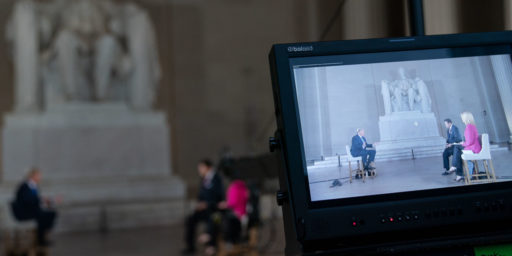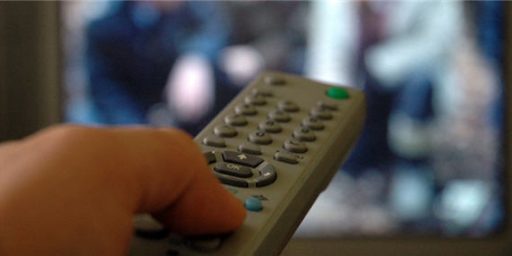State of the American News Media 2005
Yesterday’s release by The Project for Excellence in Journalism’s “State of the American News Media 2005” report is drawing substantial coverage in both traditional and new media.
Study Finds No Media Bias on War, Hits Fox News As Most One-Sided (Editor and Publisher)
[….] The Washington-based project examined more than 2,000 stories on the war in Iraq and found that 25% of the stories were negative and 20% were positive. “The majority of stories were just news,” said the project’s director, Tom Rosenstiel. Fox News Channel was twice as likely to be positive than negative, while CNN and MSNBC were evenhanded. The three network evening newscasts tended to be more negative than positive, while the opposite was true of morning shows, the study said.
A more limited analysis of campaign coverage found that Bush received more negative, and less positive, coverage than Kerry during the fall campaign. Rosenthiel thinks this may be partly because a president in office always gets more criticism, and the setbacks in the war added to this.
There are clear differences between Fox News and its cable rivals, the study found. Fox News stories contain more sources and reveal more about them than those of its competitors, but its stories are also more one-sided and are more opinionated. Indeed, Fox News journalists offer their own opinion in seven out of ten stories on the news channel, versus less than one in ten stories on CNN and one in four on MSNBC.
It’s unclear, though, what counted as a news report to begin with. Surely, “Hannity & Colmes” doesn’t count as news; it’s an opinion show. For that matter, Fox News’ flagship program, “Fox Special Report with Brit Hume,” is a pure news report for the first 40-45 minutes or so every weeknight and then culminates in a journalist roundtable where guests provide their analysis of the news. One wouldn’t expect the roundtable to be opinion-free. NRO’s Tim Graham is skeptical of this finding as well.
Further, as Michael Demmons points out, “Being ‘unbiased’ does not mean you’re obligated to a 1:1 ratio of reporting positives and negatives.” Quite right. It all depends on events on the ground.
WaPo’s Howie Kurtz, though, reports it dutifully. He cites a bit of the Fox opinion from the report:
The project defines opinion as views that are not attributed to others.
Last March, Fox reporter Todd Connor said that “Iraq has a new interim constitution and is well on its way to democracy.”
“Let’s pray it works out,” said anchor David Asman.
Another time, after hearing that Iraqis helped capture a Saddam Hussein henchman, Asman said: “Boy, that’s good news if true, the Iraqis in the lead.”
So, hoping the war that the country is fighting has a happy outcome is biased journalism, whereas sourcing one’s opinion that we shouldn’t be there in the first place to somebody else is considered objective. Got it. And one has to love this example:
Fox legal editor Stan Goldman challenged the hiring of attorney Gloria Allred to represent Amber Frey (Scott Peterson’s mistress), saying: “If you want to keep a low profile, Gloria is not the lawyer to represent you.”
Presumably, this came in response to a question and he was acting in his capacity as an analyst, not reporter. Still, it’s rather self-evident to anyone who has any knowledge of Allred.
USA Today’s Peter Johnson analyzes a different aspect of the report: “Non-traditional media gain ground, consumers.”
When Tom Rosenstiel met with a group of local TV news directors last week, they told him that viewers watch local news on average two to 21/2 times a week — a far cry from just a few years ago when “Eyewitness News” teams drew viewers every day. Now, local news anchors “can no longer say ‘As we told you yesterday,’ because chances are people weren’t watching yesterday,” says Rosenstiel, director of the Project for Excellence in Journalism, which releases its second annual State of the News Media report today.
The same phenomenon is affecting network news and newspapers, where viewers and readers are turning increasingly — and more regularly — to the Internet and cable for their news. The report finds that most news consumers now get their news from four different types of media in a typical week.
“We as journalists need to communicate in an entirely different way if readers or viewers are only with us occasionally,” he says. “We can’t assume that they are loyal or that they trust us because they use us on a regular basis. We have to forge an entirely new relationship with people who are really no longer friends but acquaintances.”
The report also offers an apparently contradictory assessment of the narrowcasting phenomenon:
The report finds that, with the exception of cable news and talk radio, the notion that consumers have retreated to ideological corners for their news is exaggerated; Democrats and Republicans both get their news from similar outlets. […] [T]he traditional “journalism of verification” — in which reporters check facts — is ceding ground to a new “journalism of assertion,” in which information is offered on radio and cable talk shows and via Internet bloggers, with little or no attempt to verify the facts.
One of the consequences is that, increasingly, citizens can no longer agree on basic facts “because everyone is consuming their own kind of personal mix of media. The chances that we know the same thing, even if we’re sitting in an office in a cubicle next to each other, is less than it used to be,” Rosenstiel says.
Such is the nature of choice. If there’s just three channels to choose from and they all have the news on at the same time, people are more likely to be watching the same thing than if there are 150 channels, 140 of which are not showing the news.






Hmmmm. Journalists who say that network news is not biased. No conflict of interest though.
Actually, I agree more with Fox News than the Networks. That shows the problem with this study, since I’m always right.
LJD: I was actually going to put exactly what you said into my post at Dean’s World:
Mainstream Media Journalists Find Mainstream Media Unbiased.
That would have been a better title for the report.
This jsut keeps getting better.
First, they threw all their support behind all-positions-all-the-time John Kerry and said they would “be good for at least 15% of the vote”.
To do this they had to pivot on Iraq and sell the idea that Bush had “lied” about WMD’s. Never mind that these chickens would have to come home to roost and that most reasonable people already knew better. Who cares? They are the annointed ones and when the annointed ones of the AMMP speak, we will listen.
Now we find out more and more and they are suffering.
It just keeps getting better…
I think the opinion of this group is a bit dubioius.
I actually agree that they are probably right in regards to foxnews, but then many of their shows are opinion oriented posts, basically editorial pages for TV. But having various sides covered in the same story, Fox does a much better job of it.
I don’t know how many talking head panels I see on other channels with one token conservative and three or four liberals. Fox tries to have one to one, or a left/right/middle as much as as possible.
I sort of like the opinion oriented aspect of Fox.